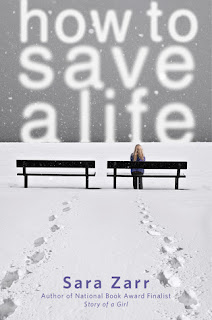Publisher: Little, Brown Books for Young Readers
Pages: 352
Series or Stand Alone: Stand Alone!
Summary: Jill MacSweeny just wishes everything could go back to normal. But ever since her dad died, she's been isolating herself from her boyfriend, her best friends--everyone who wants to support her. And when her mom decides to adopt a baby, it feels like she's somehow trying to replace a lost family member with a new one.
Mandy Kalinowski understands what it's like to grow up unwanted--to be raised by a mother who never intended to have a child. So when Mandy becomes pregnant, one thing she's sure of is that she wants a better life for her baby. It's harder to be sure of herself. Will she ever find someone to care for her, too?
As their worlds change around them, Jill and Mandy must learn to both let go and hold on, and that nothing is as easy--or as difficult--as it seems.
Critically acclaimed author and National Book Award finalist Sara Zarr delivers a heart-wrenching story, told from dual perspectives, about the many roads that can lead us home.
Review:
There were multiple reasons that I chose to read Sara Zarr’s How to Save a Life. The number one reason was the cover—I love the snow (and the far off benches). This is the same reason I’m going to read Wintertown by Stephen Emond. I also heard that Sara Zarr writes good quality contemporary books, something I’m always looking for now that I’ve rediscovered my love for contemporary YA lit. One last thing: at some point I became a sucker for books written from multiple points of view.
Prepare yourselves. I’m about to gush something fierce about this book. I absolutely loved it. Adored. Tracked down an ARC so I could keep it on my shelf and read it whenever I wanted. But first, what it’s about.
How to Save a Life tells the stories of Jill, a teenage girl still dealing with the death of her father and the idea that her mother wants to replace his presence with a new baby, and Mandy, the teenage mother of the baby Jill’s mother Robyn is openly adopting, who is coming to live with them before the baby is born. Jill doesn’t trust Many, and against the advice of her boyfriend, Dylan, enlists the help of an old high school acquaintance named Ravi to dig up dirt on Mandy’s past. Mandy’s goal in all of this is to escape the toxic environment in which she lived in order to ensure that her baby is raised out of love. The more Jill finds out about Mandy’s past that doesn’t match what she has said, the closer the girls become. The girls, along with Jill’s mother, Robin, end up discovering that family is a concept that is fluid and it can mean whatever that choose it to mean.
I adored Jill’s voice. The most important thing for me when it comes to the likability of a character is that the character isn’t beige (so maybe this also applies to real life as well. Don’t be boring, just…don’t.) Jill, right off the bat, is far from being mundane. She’s cranky, intimidates others with her attitude, and has a punk style that doesn’t make her too much of a caricature. At the same time, she wholeheartedly misses her father and grieves for him often—mostly when she believes no one is looking in her direction. Snarky chracters that demonstrate great emotional depth are the absolute best (see also: Veronica Mars from Veronica Mars).
Mandy’s voice, while entirely different from Jill’s, it was just as awesome to read as Jill’s. One thing I’m always impressed with when it comes to books with dual points of view is when an author is able to create two entirely distinct voices with which to tell a story. Sara Zarr accomplishes this impeccably—it is almost as if two different people are actually writing Jill’s and Mandy’s voices. Jill’s jaded, raw-emotion-filled voice is totally different from Mandy’s optimistic, almost emotionally-detached voice. Despite the horrors and emotional abuse she experienced, Mandy’s voice is pretty much consistently level and optimistic. Also—Jill speaks mostly in the present, whereas a lot of Mandy’s narration provides information about her past. I just thought that distinction was really cool.
All of the characters were real and incredibly likable (with the exception of Kent, Mandy’s mother’s boyfriend, but it’s not like he was supposed to be likable). The story never becomes melodramatic as a result. These characters are real and experience raw emotion without the theatricality that could have messed with the brilliance of this book. One of my favorite aspects of the book is what some might call a “love triangle” because it was able to further endear me to both of the boys in Jill’s life. Neither Dylan nor Ravi even comes close to being a jerk in this book—echoing real life more than any young adult love triangle example that I can think of. Dylan legitimately loves Jill but they aren’t right for each other any more. Ravi cared for her from afar but was only recently able to see if they could be together. They are both good people and both care for Jill, just in different ways.
Sara Zarr’s How to Save a Life was the best contemporary young adult book I read in 2011. It may have actually been my favorite book read in 2011. With its raw emotion, realistic characters, and heartbreaking connections, How to Save a Life certainly went far and above my already high expectations for Sara Zarr. Excuse me while I go off and read everything she’s ever written.
(Also—Sara Zarr’s Story of a Girl e-book is on sale this week for its five year anniversary. I already bought it, you should too.)
Rating: 5 - fan-freaking-tastic. Shelf of favorites status.

No comments:
Post a Comment